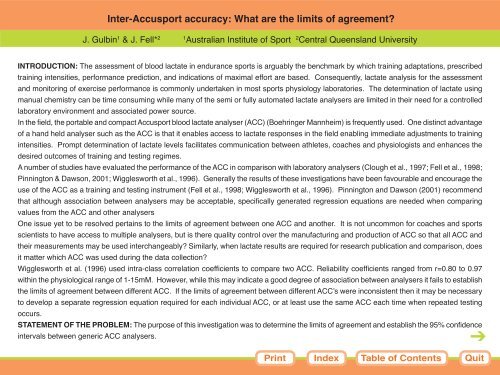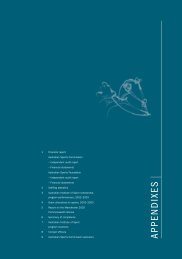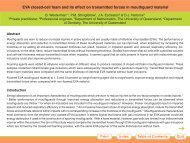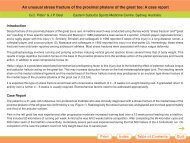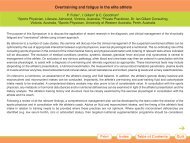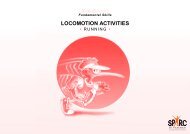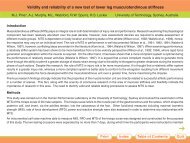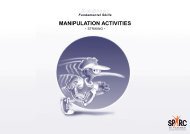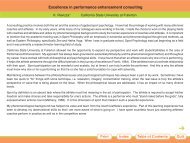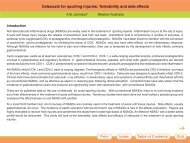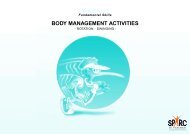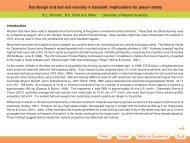Inter-Accusport accuracy: What are the limits of agreement?
Inter-Accusport accuracy: What are the limits of agreement?
Inter-Accusport accuracy: What are the limits of agreement?
Create successful ePaper yourself
Turn your PDF publications into a flip-book with our unique Google optimized e-Paper software.
<strong>Inter</strong>-<strong>Accusport</strong> <strong>accuracy</strong>: <strong>What</strong> <strong>are</strong> <strong>the</strong> <strong>limits</strong> <strong>of</strong> <strong>agreement</strong>?<br />
J. Gulbin 1 & J. Fell* 2 1 Australian Institute <strong>of</strong> Sport 2 Central Queensland University<br />
INTRODUCTION: The assessment <strong>of</strong> blood lactate in endurance sports is arguably <strong>the</strong> benchmark by which training adaptations, prescribed<br />
training intensities, performance prediction, and indications <strong>of</strong> maximal effort <strong>are</strong> based. Consequently, lactate analysis for <strong>the</strong> assessment<br />
and monitoring <strong>of</strong> exercise performance is commonly undertaken in most sports physiology laboratories. The determination <strong>of</strong> lactate using<br />
manual chemistry can be time consuming while many <strong>of</strong> <strong>the</strong> semi or fully automated lactate analysers <strong>are</strong> limited in <strong>the</strong>ir need for a controlled<br />
laboratory environment and associated power source.<br />
In <strong>the</strong> field, <strong>the</strong> portable and compact <strong>Accusport</strong> blood lactate analyser (ACC) (Boehringer Mannheim) is frequently used. One distinct advantage<br />
<strong>of</strong> a hand held analyser such as <strong>the</strong> ACC is that it enables access to lactate responses in <strong>the</strong> field enabling immediate adjustments to training<br />
intensities. Prompt determination <strong>of</strong> lactate levels facilitates communication between athletes, coaches and physiologists and enhances <strong>the</strong><br />
desired outcomes <strong>of</strong> training and testing regimes.<br />
A number <strong>of</strong> studies have evaluated <strong>the</strong> performance <strong>of</strong> <strong>the</strong> ACC in comparison with laboratory analysers (Clough et al., 1997; Fell et al., 1998;<br />
Pinnington & Dawson, 2001; Wigglesworth et al., 1996). Generally <strong>the</strong> results <strong>of</strong> <strong>the</strong>se investigations have been favourable and encourage <strong>the</strong><br />
use <strong>of</strong> <strong>the</strong> ACC as a training and testing instrument (Fell et al., 1998; Wigglesworth et al., 1996). Pinnington and Dawson (2001) recommend<br />
that although association between analysers may be acceptable, specifically generated regression equations <strong>are</strong> needed when comparing<br />
values from <strong>the</strong> ACC and o<strong>the</strong>r analysers<br />
One issue yet to be resolved pertains to <strong>the</strong> <strong>limits</strong> <strong>of</strong> <strong>agreement</strong> between one ACC and ano<strong>the</strong>r. It is not uncommon for coaches and sports<br />
scientists to have access to multiple analysers, but is <strong>the</strong>re quality control over <strong>the</strong> manufacturing and production <strong>of</strong> ACC so that all ACC and<br />
<strong>the</strong>ir measurements may be used interchangeably? Similarly, when lactate results <strong>are</strong> required for research publication and comparison, does<br />
it matter which ACC was used during <strong>the</strong> data collection?<br />
Wigglesworth et al. (1996) used intra-class correlation coefficients to comp<strong>are</strong> two ACC. Reliability coefficients ranged from r=0.80 to 0.97<br />
within <strong>the</strong> physiological range <strong>of</strong> 1-15mM. However, while this may indicate a good degree <strong>of</strong> association between analysers it fails to establish<br />
<strong>the</strong> <strong>limits</strong> <strong>of</strong> <strong>agreement</strong> between different ACC. If <strong>the</strong> <strong>limits</strong> <strong>of</strong> <strong>agreement</strong> between different ACC’s were inconsistent <strong>the</strong>n it may be necessary<br />
to develop a separate regression equation required for each individual ACC, or at least use <strong>the</strong> same ACC each time when repeated testing<br />
occurs.<br />
STATEMENT OF THE PROBLEM: The purpose <strong>of</strong> this investigation was to determine <strong>the</strong> <strong>limits</strong> <strong>of</strong> <strong>agreement</strong> and establish <strong>the</strong> 95% confidence<br />
intervals between generic ACC analysers.<br />
Print<br />
Index<br />
Table <strong>of</strong> Contents<br />
Quit
<strong>Inter</strong>-<strong>Accusport</strong> <strong>accuracy</strong>: <strong>What</strong> <strong>are</strong> <strong>the</strong> <strong>limits</strong> <strong>of</strong> <strong>agreement</strong>?<br />
J. Gulbin 1 & J. Fell* 2 1 Australian Institute <strong>of</strong> Sport 2 Central Queensland University<br />
METHODS: Four ACC were comp<strong>are</strong>d across a physiological range <strong>of</strong> blood lactate (1.9 to 16.7mmol/L). The analysers were labelled B, C, D<br />
and E and were verified before use according to <strong>the</strong> manufacturer’s instructions. Thirty-one blood samples were obtained from <strong>the</strong> fingers <strong>of</strong><br />
athletes undertaking laboratory exercise tests. Tests consisted <strong>of</strong> a series <strong>of</strong> 5 minute steady-state workloads or a 2 minute all-out effort. A<br />
125mL heparinised capillary tube was used to collect <strong>the</strong> blood at <strong>the</strong> end <strong>of</strong> each exercise effort. A standardised drop <strong>of</strong> blood (25mL) was<br />
<strong>the</strong>n randomly applied to <strong>the</strong> reagent strips <strong>of</strong> each ACC using a calibrated pipette.<br />
The mean lactate values recorded by each analyser were comp<strong>are</strong>d using a repeated measures one-way analysis <strong>of</strong> variance (ANOVA).<br />
Technical error <strong>of</strong> measurement (TEM) and percent TEM were calculated for inter-ACC comparison. Lactate measurements were <strong>the</strong>n arbitrarily<br />
grouped into three physiological ranges <strong>of</strong> interest. These approximated steady-state exercise (
Mean<br />
lactate<br />
minus<br />
selected<br />
analyser<br />
B, C, D or E<br />
(mmol/L)<br />
1.08<br />
0.54<br />
-0.54<br />
-1.08<br />
0<br />
<strong>Inter</strong>-<strong>Accusport</strong> <strong>accuracy</strong>: <strong>What</strong> <strong>are</strong> <strong>the</strong> <strong>limits</strong> <strong>of</strong> <strong>agreement</strong>?<br />
J. Gulbin 1 & J. Fell* 2 1 Australian Institute <strong>of</strong> Sport 2 Central Queensland University<br />
0 5 10 15 20<br />
Mean <strong>of</strong> lacate analysers BCDE (mmol/L)<br />
Total mean -b Total mean-c Total mean-d Total mean-e<br />
Print<br />
Index<br />
Figure 1: Bland & Altman (1986) plot<br />
demonstrating Grand mean lactate<br />
concentration (mean <strong>of</strong> all four analysers) and<br />
<strong>the</strong> difference between this mean and any<br />
individual ACC.<br />
La<br />
(mmol/L)<br />
TEM<br />
(%)<br />
< 4<br />
4.99<br />
4 to < 9<br />
4.23<br />
9 to 17<br />
3.23<br />
Table 1: Percent technical error <strong>of</strong><br />
measurement (TEM) and calculated 95%<br />
confidence interval across three blood<br />
lactate ranges.<br />
TEM (95% CI)<br />
(mmol/L)<br />
±0.41 ±0.77 ±1.19<br />
DISCUSSION: The results obtained in this<br />
investigation support <strong>the</strong> inter-ACC<br />
comparison <strong>of</strong> lactate measurements. The<br />
lack <strong>of</strong> significant differences between <strong>the</strong> analysers, <strong>the</strong> <strong>limits</strong> <strong>of</strong> <strong>agreement</strong> <strong>of</strong> ±0.54 mmol/L, and a technical error <strong>of</strong> measurement <strong>of</strong> less<br />
Mean +<br />
2SD<br />
Mean<br />
Mean -<br />
2SD<br />
Table <strong>of</strong> Contents<br />
Quit
<strong>Inter</strong>-<strong>Accusport</strong> <strong>accuracy</strong>: <strong>What</strong> <strong>are</strong> <strong>the</strong> <strong>limits</strong> <strong>of</strong> <strong>agreement</strong>?<br />
J. Gulbin 1 & J. Fell* 2 1 Australian Institute <strong>of</strong> Sport 2 Central Queensland University<br />
than 5% confirm this.<br />
Previous comparisons between different ACC have been favourable. Wigglesworth et al. (1996) reported a high degree <strong>of</strong> reliability between<br />
ACC with intra-class correlation coefficients ranging from r=0.80 to 0.97 up to 15mM, and found no significant difference between analysers<br />
using a repeated measures ANOVA. Supporting and extending on <strong>the</strong> findings by Wigglesworth and colleagues, <strong>the</strong> <strong>limits</strong> <strong>of</strong> <strong>agreement</strong> or<br />
approximate 95% confidence interval (m±2SD; [0.54mmol/L]) between <strong>the</strong> multiple ACC reported in this study <strong>are</strong> well within clinically acceptable<br />
levels for hand held analysers <strong>of</strong> this type (American Diabetes Association, 1995).<br />
The physiological range measured in this study (1.9-16.7mmol/L) may not encompass all blood lactate concentrations elicited during rest and<br />
supra-maximal exercise. Measured values in <strong>the</strong>se upper ranges <strong>of</strong> lactate concentration should be treated with some caution. This is partly<br />
due to evidence <strong>of</strong> heteroscedasticity (a relationship between <strong>the</strong> degree <strong>of</strong> disparity between analysers and <strong>the</strong> level <strong>of</strong> lactate measured)<br />
above 10mmol/L (Figure 1). Similar findings at higher blood lactate concentrations have been reported by Pyne et al. (2000), Pinnington &<br />
Dawson (2001) and Fell et al. (1998) when comparing <strong>the</strong> ACC with o<strong>the</strong>r instruments <strong>of</strong> lactate analysis. While <strong>the</strong> <strong>limits</strong> <strong>of</strong> <strong>agreement</strong> have<br />
been demonstrated to be statistically acceptable throughout <strong>the</strong> most likely measured range, users should be aw<strong>are</strong> that <strong>the</strong> greatest variability<br />
between values occurs at <strong>the</strong> higher lactate concentrations.<br />
Explaining <strong>the</strong> slight variation between analysers can be <strong>the</strong> subject <strong>of</strong> some speculation. These may be related to sample homogeneity,<br />
sample stability, sample size, and equipment performance.<br />
Sample homogeneity: While a 25mL blood sample is required to measure lactate using <strong>the</strong> ACC, a five-fold sample was collected in <strong>the</strong> present<br />
study. It is not uncommon for exercise scientists to collect sufficient blood during a single draw (125mL) to analyse a number <strong>of</strong> rheological<br />
- parameters <strong>of</strong> interest (eg. pH, HCO , glucose, lactate). Therefore, it may be possible that during a complicated or extended blood draw (up<br />
3<br />
to one minute), lactate concentration may change during collection as lactate continues to diffuse into <strong>the</strong> blood from <strong>the</strong> muscle cells (Bishop<br />
& Martino, 1993). Although in <strong>the</strong> present study <strong>the</strong> samples were drawn relatively quickly by an experienced phlebotomist, sample inhomogeneity<br />
cannot be completely discounted.<br />
Sample stability: In this study blood samples were not treated to arrest erythrocyte glycolysis in-vitro. A mean increase in lactate in <strong>the</strong> absence<br />
<strong>of</strong> a glycolytic inhibitor <strong>of</strong> 0.42mmol/L per hour has been shown (Astles et al., 1994). However, Williams et al. (1992) reported no mean change<br />
Print<br />
Index<br />
Table <strong>of</strong> Contents<br />
Quit
<strong>Inter</strong>-<strong>Accusport</strong> <strong>accuracy</strong>: <strong>What</strong> <strong>are</strong> <strong>the</strong> <strong>limits</strong> <strong>of</strong> <strong>agreement</strong>?<br />
J. Gulbin 1 & J. Fell* 2 1 Australian Institute <strong>of</strong> Sport 2 Central Queensland University<br />
in lactate concentration over 18 minutes at 20oC (24 samples). As all samples were processed within 60 seconds, it is improbable that any<br />
latent period between <strong>the</strong> first and final application <strong>of</strong> blood to <strong>the</strong> test strip would cause lactate variability in <strong>the</strong> sample.<br />
Sample size: While minor pipette errors during transfer from capillary tube to analyser cannot be discounted, Fell et al. (1998) have reported no<br />
differences in <strong>the</strong> measured lactate concentrations for drop sizes between 20 and 50mL. Therefore when using a sample size <strong>of</strong> 25mL pipette<br />
errors <strong>of</strong> up to 20% should have no impact on measured lactate concentration. <strong>Inter</strong>estingly, Pyne et al., (2000) have recently discussed <strong>the</strong><br />
convenience <strong>of</strong> an alternative blood lactate analyser (Lactate ProTM ) which minimises <strong>the</strong> potential for experimental error via manual transfer.<br />
‘Double handling’ <strong>of</strong> blood samples for assay using <strong>the</strong> ACC is an <strong>are</strong>a that requires fur<strong>the</strong>r investigation.<br />
Equipment performance: Despite previously mentioned studies supporting ACC precision <strong>the</strong>re remains an aspect <strong>of</strong> ambiguity in <strong>the</strong> quality<br />
control solutions provided by <strong>the</strong> manufacturer for <strong>the</strong> assessment <strong>of</strong> instrument precision. The solutions <strong>are</strong> merely labelled high and low and<br />
have an indicated acceptable range (low: 1.7-3.1mmol/L and high: 4.5-7.0mmol/L). In <strong>the</strong> present study, <strong>the</strong>re was no known lactate concentration<br />
used as a reference solution. Therefore, unlike o<strong>the</strong>r laboratory analysers <strong>the</strong>re is no way <strong>of</strong> knowing whe<strong>the</strong>r any given ACC is measuring at,<br />
above or below <strong>the</strong> precise concentration.<br />
CONCLUSIONS: There is good <strong>agreement</strong> between generic ACC over <strong>the</strong> range <strong>of</strong> blood lactates <strong>of</strong> physiological interest. ACC users can be<br />
confident that each analyser will measure each respective blood lactate measurement reliably with a technical error <strong>of</strong> measurement <strong>of</strong> less<br />
than 5%.<br />
ACKNOWLEDGMENTS: The authors would like to thank <strong>the</strong> assistance provided by <strong>the</strong> South Australian Sports Institute (SASI).<br />
REFERENCES:<br />
1. American Diabetes Association (1995). Consensus statement on self-monitoring <strong>of</strong> blood glucose. Diabetes C<strong>are</strong> 18: 46-52.<br />
2. Astles, R., Williams, C. P. & Sedor, F. (1994). Stability <strong>of</strong> plasma lactate in vitro in <strong>the</strong> presence <strong>of</strong> antiglycolytic agents. Clinical Chemistry<br />
40(7): 1327-1330.<br />
3. Atkinson, G. & Neville, A. M. (1998). Statistical methods for assessing measurement error (reliability) in variables relevant to sports<br />
medicine. Sports Medicine 26: 217-238.<br />
4. Bishop, P. & Martino, M. (1993). Blood lactate measurement in recovery as an adjunct to training. Practical considerations. Sports<br />
Medicine 16: 5-13.<br />
Print<br />
Index<br />
Table <strong>of</strong> Contents<br />
Quit
<strong>Inter</strong>-<strong>Accusport</strong> <strong>accuracy</strong>: <strong>What</strong> <strong>are</strong> <strong>the</strong> <strong>limits</strong> <strong>of</strong> <strong>agreement</strong>?<br />
J. Gulbin 1 & J. Fell* 2 1 Australian Institute <strong>of</strong> Sport 2 Central Queensland University<br />
5. Bland, J.M. & Altman, D.G. (1986). Statistical methods for assessing <strong>agreement</strong> between two methods <strong>of</strong> clinical measurement. The<br />
Lancet Feb 8: 301-310.<br />
6. Clough, M., Martin, D. T., Pyne, D., Kearns, A., Lee, H., Ryan, R., Ashenden, M. & Hahn, A. (1997). <strong>Inter</strong>pretation <strong>of</strong> <strong>Accusport</strong> blood l<br />
actate results - How do <strong>the</strong>y comp<strong>are</strong> with YSI 2300 Stat values? Australian Conference <strong>of</strong> Science and Medicine in Sport. Sports<br />
Medicine Australia, Bruce, ACT 2616 Australia, pp 82-83.<br />
7. Fell, J.W., Rayfield, J. M., Gulbin, J. P. & Gaffney, P. T. (1998). Evaluation <strong>of</strong> <strong>the</strong> <strong>Accusport</strong> lactate analyser. <strong>Inter</strong>national Journal <strong>of</strong><br />
Sports Medicine 19: 199-204.<br />
8. Pinnington, H. & Dawson, B. (2001). Examination <strong>of</strong> <strong>the</strong> validity and reliability <strong>of</strong> <strong>the</strong> <strong>Accusport</strong> blood lactate analyser. Journal <strong>of</strong> Science<br />
and Medicine in Sport 4(1): 129-138.<br />
9. Pyne, D. B., Boston, T., Martin, D. T. & Logan, A. (2000). Evaluation <strong>of</strong> <strong>the</strong> Lactate ProTM blood lactate analyser. European Journal <strong>of</strong><br />
Applied Physiology 82(1/2): 112-116.<br />
10. Wigglesworth, J. K., LaMere, V. J., Rowland, N. D. & Miller, L. (1996). Examination <strong>of</strong> <strong>the</strong> reliability and validity <strong>of</strong> a new blood lactate<br />
analyzer. Medicine and Science in Sports and Exercise 28: S10 (Abstract 59).<br />
Williams, J. R., Armstrong, N. & Kirby, B. J. (1992). The influence <strong>of</strong> <strong>the</strong> site <strong>of</strong> sampling and assay medium upon <strong>the</strong> measurement and<br />
interpretation <strong>of</strong> blood lactate responses to exercise. Journal <strong>of</strong> Sports Sciences 10: 95-107.<br />
Print<br />
Index<br />
Table <strong>of</strong> Contents<br />
Quit
<strong>Inter</strong>-<strong>Accusport</strong> <strong>accuracy</strong>: <strong>What</strong> <strong>are</strong> <strong>the</strong> <strong>limits</strong> <strong>of</strong> <strong>agreement</strong>?<br />
J. Gulbin 1 & J. Fell* 2<br />
1Australian Institute <strong>of</strong> Sport<br />
2Central Queensland University<br />
INTRODUCTION: The assessment <strong>of</strong> blood lactate in endurance sports is arguably <strong>the</strong> benchmark by which<br />
training adaptations, prescribed training intensities, performance prediction, and indications <strong>of</strong> maximal effort <strong>are</strong><br />
based. Consequently, lactate analysis for <strong>the</strong> assessment and monitoring <strong>of</strong> exercise performance is commonly<br />
undertaken in most sports physiology laboratories. The determination <strong>of</strong> lactate using manual chemistry can be<br />
time consuming while many <strong>of</strong> <strong>the</strong> semi or fully automated lactate analysers <strong>are</strong> limited in <strong>the</strong>ir need for a<br />
controlled laboratory environment and associated power source.<br />
In <strong>the</strong> field, <strong>the</strong> portable and compact <strong>Accusport</strong> blood lactate analyser (ACC) (Boehringer Mannheim) is<br />
frequently used. One distinct advantage <strong>of</strong> a hand held analyser such as <strong>the</strong> ACC is that it enables access to<br />
lactate responses in <strong>the</strong> field enabling immediate adjustments to training intensities. Prompt determination <strong>of</strong><br />
lactate levels facilitates communication between athletes, coaches and physiologists and enhances <strong>the</strong> desired<br />
outcomes <strong>of</strong> training and testing regimes.<br />
A number <strong>of</strong> studies have evaluated <strong>the</strong> performance <strong>of</strong> <strong>the</strong> ACC in comparison with laboratory analysers<br />
(Clough et al., 1997; Fell et al., 1998; Pinnington & Dawson, 2001; Wigglesworth et al., 1996). Generally <strong>the</strong><br />
results <strong>of</strong> <strong>the</strong>se investigations have been favourable and encourage <strong>the</strong> use <strong>of</strong> <strong>the</strong> ACC as a training and testing<br />
instrument (Fell et al., 1998; Wigglesworth et al., 1996). Pinnington and Dawson (2001) recommend that although<br />
association between analysers may be acceptable, specifically generated regression equations <strong>are</strong> needed when<br />
comparing values from <strong>the</strong> ACC and o<strong>the</strong>r analysers<br />
One issue yet to be resolved pertains to <strong>the</strong> <strong>limits</strong> <strong>of</strong> <strong>agreement</strong> between one ACC and ano<strong>the</strong>r. It is not<br />
uncommon for coaches and sports scientists to have access to multiple analysers, but is <strong>the</strong>re quality control over<br />
<strong>the</strong> manufacturing and production <strong>of</strong> ACC so that all ACC and <strong>the</strong>ir measurements may be used interchangeably?<br />
Similarly, when lactate results <strong>are</strong> required for research publication and comparison, does it matter which ACC<br />
was used during <strong>the</strong> data collection?<br />
Wigglesworth et al. (1996) used intra-class correlation coefficients to comp<strong>are</strong> two ACC. Reliability coefficients<br />
ranged from r=0.80 to 0.97 within <strong>the</strong> physiological range <strong>of</strong> 1-15mM. However, while this may indicate a good<br />
degree <strong>of</strong> association between analysers it fails to establish <strong>the</strong> <strong>limits</strong> <strong>of</strong> <strong>agreement</strong> between different ACC. If <strong>the</strong><br />
<strong>limits</strong> <strong>of</strong> <strong>agreement</strong> between different ACC's were inconsistent <strong>the</strong>n it may be necessary to develop a separate<br />
regression equation required for each individual ACC, or at least use <strong>the</strong> same ACC each time when repeated<br />
testing occurs.<br />
STATEMENT OF THE PROBLEM: The purpose <strong>of</strong> this investigation was to determine <strong>the</strong> <strong>limits</strong> <strong>of</strong> <strong>agreement</strong><br />
and establish <strong>the</strong> 95% confidence intervals between generic ACC analysers.<br />
METHODS: Four ACC were comp<strong>are</strong>d across a physiological range <strong>of</strong> blood lactate (1.9 to 16.7mmol/L). The<br />
analysers were labelled B, C, D and E and were verified before use according to <strong>the</strong> manufacturer's instructions.<br />
Thirty-one blood samples were obtained from <strong>the</strong> fingers <strong>of</strong> athletes undertaking laboratory exercise tests. Tests<br />
consisted <strong>of</strong> a series <strong>of</strong> 5 minute steady-state workloads or a 2 minute all-out effort. A 125μL heparinised<br />
capillary tube was used to collect <strong>the</strong> blood at <strong>the</strong> end <strong>of</strong> each exercise effort. A standardised drop <strong>of</strong> blood<br />
(25μL) was <strong>the</strong>n randomly applied to <strong>the</strong> reagent strips <strong>of</strong> each ACC using a calibrated pipette.<br />
The mean lactate values recorded by each analyser were comp<strong>are</strong>d using a repeated measures one-way<br />
analysis <strong>of</strong> variance (ANOVA). Technical error <strong>of</strong> measurement (TEM) and percent TEM were calculated for inter-<br />
ACC comparison. Lactate measurements were <strong>the</strong>n arbitrarily grouped into three physiological ranges <strong>of</strong> interest.<br />
These approximated steady-state exercise (
Figure 1 is a Bland & Altman (1986) plot depicting <strong>the</strong> Grand mean lactate concentration for any single blood<br />
sample (mean <strong>of</strong> ACC B, C, D and E) comp<strong>are</strong>d with <strong>the</strong> difference between <strong>the</strong> Grand mean and <strong>the</strong> value from<br />
any individual analyser (e.g. Grand mean minus B, or C, or D, or E). The <strong>limits</strong> <strong>of</strong> <strong>agreement</strong>, or <strong>the</strong> approximate<br />
95% confidence interval (μ±2SD) for <strong>the</strong> analyser is ±0.54 mmol/L. The technical error <strong>of</strong> measurement (TEM)<br />
and % TEM at blood lactate concentrations <strong>of</strong> < 4 mmol/L, 4 to < 9 mmol/L, and 9 to 17 mmol/L <strong>are</strong> 0.14 (4.99%),<br />
0.27 (4.23%) and 0.42 mmol/L (3.23%) respectively (Table 1).<br />
Mean<br />
lactate<br />
minus<br />
selected<br />
analyser<br />
B, C, D or E<br />
(mmol/L)<br />
Figure 1: Bland & Altman (1986) plot demonstrating Grand mean lactate concentration (mean <strong>of</strong> all four<br />
analysers) and <strong>the</strong> difference between this mean and any individual ACC.<br />
La<br />
(mmol/L)<br />
TEM<br />
(%)<br />
TEM (95% CI)<br />
(mmol/L)<br />
1.08<br />
0.54<br />
-0.54<br />
-1.08<br />
0<br />
0 5 10 15 20<br />
Mean <strong>of</strong> lacate analysers BCDE (mmol/L)<br />
Total mean -b Total mean-c Total mean-d Total mean-e<br />
< 4 4 to < 9 9 to 17<br />
4.99 4.23 3.23<br />
±0.41 ±0.77 ±1.19<br />
Mean +<br />
2SD<br />
Table 1: Percent technical error <strong>of</strong> measurement (TEM) and calculated 95% confidence interval across three<br />
blood lactate ranges.<br />
DISCUSSION: The results obtained in this investigation support <strong>the</strong> inter-ACC comparison <strong>of</strong> lactate<br />
measurements. The lack <strong>of</strong> significant differences between <strong>the</strong> analysers, <strong>the</strong> <strong>limits</strong> <strong>of</strong> <strong>agreement</strong> <strong>of</strong> ±0.54<br />
mmol/L, and a technical error <strong>of</strong> measurement <strong>of</strong> less than 5% confirm this.<br />
Previous comparisons between different ACC have been favourable. Wigglesworth et al. (1996) reported a<br />
high degree <strong>of</strong> reliability between ACC with intra-class correlation coefficients ranging from r=0.80 to 0.97 up to<br />
15mM, and found no significant difference between analysers using a repeated measures ANOVA. Supporting<br />
and extending on <strong>the</strong> findings by Wigglesworth and colleagues, <strong>the</strong> <strong>limits</strong> <strong>of</strong> <strong>agreement</strong> or approximate 95%<br />
confidence interval (μ±2SD; [0.54mmol/L]) between <strong>the</strong> multiple ACC reported in this study <strong>are</strong> well within<br />
clinically acceptable levels for hand held analysers <strong>of</strong> this type (American Diabetes Association, 1995).<br />
The physiological range measured in this study (1.9-16.7mmol/L) may not encompass all blood lactate<br />
concentrations elicited during rest and supra-maximal exercise. Measured values in <strong>the</strong>se upper ranges <strong>of</strong> lactate<br />
concentration should be treated with some caution. This is partly due to evidence <strong>of</strong> heteroscedasticity (a<br />
relationship between <strong>the</strong> degree <strong>of</strong> disparity between analysers and <strong>the</strong> level <strong>of</strong> lactate measured) above<br />
10mmol/L (Figure 1). Similar findings at higher blood lactate concentrations have been reported by Pyne et al.<br />
(2000), Pinnington & Dawson (2001) and Fell et al. (1998) when comparing <strong>the</strong> ACC with o<strong>the</strong>r instruments <strong>of</strong><br />
lactate analysis. While <strong>the</strong> <strong>limits</strong> <strong>of</strong> <strong>agreement</strong> have been demonstrated to be statistically acceptable throughout<br />
<strong>the</strong> most likely measured range, users should be aw<strong>are</strong> that <strong>the</strong> greatest variability between values occurs at <strong>the</strong><br />
higher lactate concentrations.<br />
Explaining <strong>the</strong> slight variation between analysers can be <strong>the</strong> subject <strong>of</strong> some speculation. These may be<br />
related to sample homogeneity, sample stability, sample size, and equipment performance.<br />
Mean<br />
Mean -<br />
2SD
Sample homogeneity: While a 25μL blood sample is required to measure lactate using <strong>the</strong> ACC, a five-fold<br />
sample was collected in <strong>the</strong> present study. It is not uncommon for exercise scientists to collect sufficient blood<br />
during a single draw (125μL) to analyse a number <strong>of</strong> rheological parameters <strong>of</strong> interest (eg. pH, HCO3 -, glucose,<br />
lactate). Therefore, it may be possible that during a complicated or extended blood draw (up to one minute),<br />
lactate concentration may change during collection as lactate continues to diffuse into <strong>the</strong> blood from <strong>the</strong> muscle<br />
cells (Bishop & Martino, 1993). Although in <strong>the</strong> present study <strong>the</strong> samples were drawn relatively quickly by an<br />
experienced phlebotomist, sample inhomogeneity cannot be completely discounted.<br />
Sample stability: In this study blood samples were not treated to arrest erythrocyte glycolysis in-vitro. A mean<br />
increase in lactate in <strong>the</strong> absence <strong>of</strong> a glycolytic inhibitor <strong>of</strong> 0.42mmol/L per hour has been shown (Astles et al.,<br />
1994). However, Williams et al. (1992) reported no mean change in lactate concentration over 18 minutes at 20 oC<br />
(24 samples). As all samples were processed within 60 seconds, it is improbable that any latent period between<br />
<strong>the</strong> first and final application <strong>of</strong> blood to <strong>the</strong> test strip would cause lactate variability in <strong>the</strong> sample.<br />
Sample size: While minor pipette errors during transfer from capillary tube to analyser cannot be discounted,<br />
Fell et al. (1998) have reported no differences in <strong>the</strong> measured lactate concentrations for drop sizes between 20<br />
and 50μL. Therefore when using a sample size <strong>of</strong> 25μL pipette errors <strong>of</strong> up to 20% should have no impact on<br />
measured lactate concentration. <strong>Inter</strong>estingly, Pyne et al., (2000) have recently discussed <strong>the</strong> convenience <strong>of</strong> an<br />
alternative blood lactate analyser (Lactate Pro TM) which minimises <strong>the</strong> potential for experimental error via manual<br />
transfer. 'Double handling' <strong>of</strong> blood samples for assay using <strong>the</strong> ACC is an <strong>are</strong>a that requires fur<strong>the</strong>r<br />
investigation.<br />
Equipment performance: Despite previously mentioned studies supporting ACC precision <strong>the</strong>re remains an<br />
aspect <strong>of</strong> ambiguity in <strong>the</strong> quality control solutions provided by <strong>the</strong> manufacturer for <strong>the</strong> assessment <strong>of</strong> instrument<br />
precision. The solutions <strong>are</strong> merely labelled high and low and have an indicated acceptable range (low: 1.7-<br />
3.1mmol/L and high: 4.5-7.0mmol/L). In <strong>the</strong> present study, <strong>the</strong>re was no known lactate concentration used as a<br />
reference solution. Therefore, unlike o<strong>the</strong>r laboratory analysers <strong>the</strong>re is no way <strong>of</strong> knowing whe<strong>the</strong>r any given<br />
ACC is measuring at, above or below <strong>the</strong> precise concentration.<br />
CONCLUSIONS: There is good <strong>agreement</strong> between generic ACC over <strong>the</strong> range <strong>of</strong> blood lactates <strong>of</strong><br />
physiological interest. ACC users can be confident that each analyser will measure each respective blood lactate<br />
measurement reliably with a technical error <strong>of</strong> measurement <strong>of</strong> less than 5%.<br />
ACKNOWLEDGMENTS: The authors would like to thank <strong>the</strong> assistance provided by <strong>the</strong> South Australian<br />
Sports Institute (SASI).<br />
REFERENCES:<br />
1. American Diabetes Association (1995). Consensus statement on self-monitoring <strong>of</strong> blood glucose.<br />
Diabetes C<strong>are</strong> 18: 46-52.<br />
2. Astles, R., Williams, C. P. & Sedor, F. (1994). Stability <strong>of</strong> plasma lactate in vitro in <strong>the</strong> presence <strong>of</strong><br />
antiglycolytic agents. Clinical Chemistry 40(7): 1327-1330.<br />
3. Atkinson, G. & Neville, A. M. (1998). Statistical methods for assessing measurement error (reliability) in<br />
variables relevant to sports medicine. Sports Medicine 26: 217-238.<br />
4. Bishop, P. & Martino, M. (1993). Blood lactate measurement in recovery as an adjunct to training.<br />
Practical considerations. Sports Medicine 16: 5-13.<br />
5. Bland, J.M. & Altman, D.G. (1986). Statistical methods for assessing <strong>agreement</strong> between two methods <strong>of</strong><br />
clinical measurement. The Lancet Feb 8: 301-310.<br />
6. Clough, M., Martin, D. T., Pyne, D., Kearns, A., Lee, H., Ryan, R., Ashenden, M. & Hahn, A. (1997).<br />
<strong>Inter</strong>pretation <strong>of</strong> <strong>Accusport</strong> blood lactate results - How do <strong>the</strong>y comp<strong>are</strong> with YSI 2300 Stat values?<br />
Australian Conference <strong>of</strong> Science and Medicine in Sport. Sports Medicine Australia, Bruce, ACT 2616<br />
Australia, pp 82-83.<br />
7. Fell, J.W., Rayfield, J. M., Gulbin, J. P. & Gaffney, P. T. (1998). Evaluation <strong>of</strong> <strong>the</strong> <strong>Accusport</strong> lactate<br />
analyser. <strong>Inter</strong>national Journal <strong>of</strong> Sports Medicine 19: 199-204.<br />
8. Pinnington, H. & Dawson, B. (2001). Examination <strong>of</strong> <strong>the</strong> validity and reliability <strong>of</strong> <strong>the</strong> <strong>Accusport</strong> blood<br />
lactate analyser. Journal <strong>of</strong> Science and Medicine in Sport 4(1): 129-138.<br />
9. Pyne, D. B., Boston, T., Martin, D. T. & Logan, A. (2000). Evaluation <strong>of</strong> <strong>the</strong> Lactate Pro TM blood lactate<br />
analyser. European Journal <strong>of</strong> Applied Physiology 82(1/2): 112-116.<br />
10. Wigglesworth, J. K., LaMere, V. J., Rowland, N. D. & Miller, L. (1996). Examination <strong>of</strong> <strong>the</strong> reliability and<br />
validity <strong>of</strong> a new blood lactate analyzer. Medicine and Science in Sports and Exercise 28: S10 (Abstract<br />
59).
11. Williams, J. R., Armstrong, N. & Kirby, B. J. (1992). The influence <strong>of</strong> <strong>the</strong> site <strong>of</strong> sampling and assay<br />
medium upon <strong>the</strong> measurement and interpretation <strong>of</strong> blood lactate responses to exercise. Journal <strong>of</strong><br />
Sports Sciences 10: 95-107.


